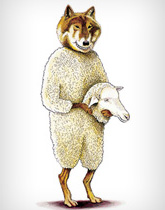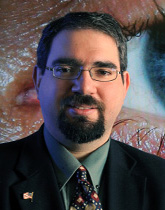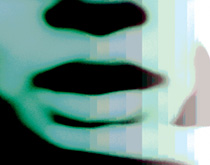
The Marines have walled off Fallujah in the heart of Iraq’s volatile Anbar province—closing its dusty, labyrinthine roads to traffic. The only way into the ancient Sunni city is through a military checkpoint. The only way past a checkpoint is to have an identification badge that proves your residency. And the only way to get a badge is to have American soldiers snap your picture, scan your irises, and take all 10 of your fingerprints.
It's a scorching July morning at the edge of the desert, and one Iraqi after another walks single-file into a former schoolhouse barricaded with sandbags and razor wire. Those without ID badges are asked to give their names and birthdates and told to place each finger on glowing green scanners. Next, they are instructed to stare into a handheld, camera-like device that captures and stores the unique pattern of both of their irises. The information is then cross-checked against a database of detainees and suspected terrorists. The Marines use this high-tech fishing net to trap insurgents trying to enter the war-ravaged city.
But what if the target is the checkpoint itself? By the time a soldier goes to swipe a badge or create a new one, it could already be too late.
In January, a suicide bomber wearing an explosive vest killed 35 religious pilgrims and injured dozens more at a security checkpoint outside a shrine near Baghdad. Four months later, a man dressed in a police uniform killed four guards and seven civilians and wounded eight U.S. soldiers in an attack at a checkpoint in northeast Iraq.
Halfway around the globe, the sun set hours ago. But for a research assistant professor in Carnegie Mellon's Department of Electrical and Computer Engineering and CyLab, there is still a grant proposal to finish, a technical paper to edit, and bugs to fix in the project demo for a Congressional delegation next week. After pulling another all-nighter, Marios Savvides is off to D.C. at daybreak for classified meetings with high-ranking military and intelligence officers. Savvides, who is also the founding director of the university’s CyLab Biometrics Lab, is developing biometrics technologies that could mean the difference between life and death in places like Fallujah.
The gray hair peppering his dark beard betrays his exhaustion, but rest isn’t coming soon for the 33-year-old cybersecurity expert. He knows firsthand what U.S. military forces face when they are stationed in unstable parts of the world—and he knows to savor the freedoms he now enjoys in America. Born in southern Cyprus, he spent his childhood moving every three years to countries such as Nigeria, Kuwait, Dubai, and Oman, where his father took posts as a field irrigation engineer for the Food and Agriculture Organization of the United Nations, bringing food and a chance at survival to those without. The power of technology to improve the human condition did not go unnoticed by the son.
"He touched people who never even had a bowl of rice," Savvides recalls, "but they could make all the rice that they needed when he finished an irrigation project."
For the younger Savvides, hope flows not in the form of water, but electrical currents. In 1997, he earned his undergraduate degree in microelectronics systems engineering at the University of Manchester Institute of Science and Technology in England. There, “just for fun,” he designed a computer-controlled security system that would instantly fax and email images of a room if thieves tried to break in the windows. "I was always into computer surveillance," says Savvides, adjusting the American flag lapel pin affixed to his sports coat. "I guess I just love being able to look at a screen and know what is going on around me."
It's a passion that followed him to graduate school at Carnegie Mellon, where he was drawn by the university’s long, storied research tradition in face detection and tracking—the process of automatically locating human faces in digital images and video, as well as facial recognition, or determining whether two faces are the same.
In the 1970s, Carnegie Mellon computer vision pioneer Takeo Kanade built the first complete computer program to identify the human face. Kanade has continued to perfect those methods ever since as head of the Robotics Institute’s Face Group. And Pittsburgh Pattern Recognition Inc., a Carnegie Mellon spinoff founded in 2004, is commercializing recognition technologies headed by chief executive officer and founder Henry Schneiderman (E'90, CS'00), cofounder Michael Nechyba (CS'98), and Michael Sipe (E'99). Research in this area also is a mainstay in the university’s engineering program, where scientists Vijayakumar Bhagavatula and David Casasent have worked for decades to develop better algorithms for facial recognition—a type of biometrics technology.
Savvides' expertise is in the nascent field of biometrics, which refers to the automatic identification of people using bodily characteristics, including their faces, eyes, fingers, hands, palm prints, and voices. Think of James Bond pressing his palm against a special reader, and—boom!—the door opens as a sexy female voice welcomes him: "Hello, Mr. Bond." Or Steven Spielberg’s sci-fi thriller Minority Report in which John Anderton, played by Tom Cruise, resorts to an eyeball transplant to elude Big Brother–like iris scanners.
But biometrics is no longer just the futuristic purview of Hollywood or Orwellian prophecy. Despite lingering concerns about privacy and reliability, it is cropping up all over, verifying the identities of people who are dining at college cafeterias, logging into their personal computers, signing up for welfare benefits, punching in at factories, entering casinos and gyms, cashing checks, picking up kids at day care, visiting Disney World.
In these instances, the users cooperate fully. But since the deadly terrorist attacks of 9-11, the U.S. government has invested millions of dollars in biometrics research to create identification systems that can keep track of potential terrorists trying to stay under the radar—a much more challenging scientific problem than coordinating admissions to Disney World.
"Biometrics is becoming an integral part of security around the world, and the field is growing exponentially," says biometrics expert and government consultant Michael Yura. He describes Savvides as a "one-man wrecking crew" in the emerging discipline—someone with the technical savvy, entrepreneurial spirit, and patriotic resolve to do research that will save lives on the battlefield and the home front.

In 2004, Savvides earned his doctorate in engineering from Carnegie Mellon, working under Bhagavatula and Pradeep Khosla, dean of the Carnegie Institute of Technology (www.cit.cmu.edu), to apply a mathematical tool called correlation filters to facial recognition. Correlation filters convert an image into wave-like patterns that can then be compared by a computer in a way that is more tolerant of some of these differences. "I’ve been working on correlation filters for a long time and was happy developing the theory behind it and writing papers," says Bhagavatula. "But Marios was the first student of mine who took it to the next level and actually built big systems to demonstrate how these ideas work. That’s something you don’t see very often."
In 2006, Savvides' algorithms took the top academic prize and beat many commercial products in the Face Recognition Grand Challenge—a government-sponsored research contest that was held to improve facial recognition technology so it could be deployed in the global war on terror. Matching two faces is surprisingly hard for a computer. The shape and size of faces vary widely, as do skin color and facial hair. Add the complexity of lighting variation, aging, orientation of the head, and sunglasses and other accessories, and machines can be positively baffled. In the challenge, Savvides' algorithms matched faces nearly seven times better than existing systems.
Even with the improved recognition, facial recognition programs still work best when deciphering posed, well-illuminated images. Not very practical if all you have to go on is a surveillance video of a suspected terrorist in a hat and glasses walking face down through a crowded airport to evade cameras; or if you’re trying to identify a suspicious person approaching a U.S. military site at dusk in the Iraqi desert or the mountains of Pakistan.
So, it stands to reason that the matching process would be a lot faster and more reliable if it got better images of uncooperative subjects in the first place. That’s a big part of what Savvides is working on in the CyLab Biometrics Lab (https://biometrics.cylab.cmu.edu/) he founded three years ago and has built to a full grown Center for Biometrics. The center is largely funded by grants from an alphabet soup of U.S. federal agencies—roughly $3 million this year alone. In another boost to his research program, Savvides recently was named as one of four scientists to be part of the Center for Academic Studies in Identity Sciences, which falls under the auspices of Dennis Blair, the nation's director of national intelligence. Blair acts as the principal advisor to President Obama, the National Security Council, and the Homeland Security Council for intelligence matters related to national security.
In Savvides' lab—where on any given day you will find more than a dozen PhD and undergraduate students working with a palpable sense of urgency—everyone is hustling to develop a robust, multimodal suite of biometrics tools for identifying people at a distance—especially those who don’t want to be recognized—to protect against terrorist attacks.

To demonstrate his lab’s latest research, Savvides steps in front of a computer outfitted with a camera trained to lock in on his face. The camera follows him even as he backs far away from the screen into the hallway, and it zooms in to obtain a higher-resolution image. The system then hones in further on his eyes to capture the detail in his irises.
There’s more:
- A computer program takes a 2D image (for example, a newspaper clipping or ATM surveillance screen shot taken from any angle, even under poor lighting conditions) and rapidly translates it into a 3D model. The software makes an educated guess about what the occluded parts of the face should look like, and the resulting 3D image can be rotated to create a front-facing 2D version for use in facial recognition of images captured from surveillance footage at any angle.
- Another computer program identifies the gender of a person in a photo and whether the individual has facial hair or glasses, so facial recognition systems can automatically take those variables into account when making matches.
- Still another program automatically pinpoints 79 locations along the shape of the face, a process called facial landmarking, which currently requires painstaking handiwork by intelligence agents matching photos against thousands stored in a database. This technology will soon be integrated into the FBI’s universal workstation for forensic facial analysis.
- And, with obvious pride, Savvides shows off the Iris on the Move machine in his lab. The black portal, originally developed by Sarnoff Inc., resembles a normal metal detector, but as a person walks through, it automatically captures an iris image of both eyes. With the support of a $1.5 million grant from the U.S. Defense Department, Savvides has extended the range of the system up to 43 feet, nearly four times farther than any currently available on the market. He aims to have a mobile version of this technology in the hands of U.S. troops by 2012. Using this system—which could be mounted at a military command post and automatically scan and identify anyone in the surrounding perimeter—soldiers could enroll detainees in their biometrics database at a distance rather than when they are close enough to kill, or verify the identities of people passing through a guard station well before they can cause any harm.
After the show-and-tell ends, Savvides gets back to work. Tonight there are still dozens of emails to answer, a project deadline to meet, lab equipment to order, lecture notes to review, another proposal to write, and a conference to plan. He opens his laptop just as the early-morning call to prayer is sounded across Iraq, and, once again, the line of people begins to form all too close to the soldiers guarding Fallujah.
Jennifer Bails is an award-winning former newspaper reporter. She is a regular contributor to this magazine.



